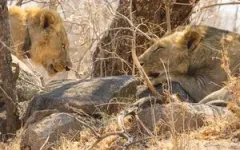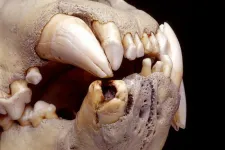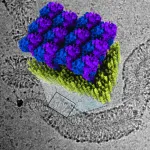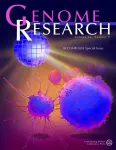In a new study, Field Museum researchers collaborated with scientists at the University of Illinois Urbana-Champaign on an in-depth analysis of hairs carefully extracted from the lions’ broken teeth. The study used microscopy and genomics to identify some of the species the lions consumed. The findings are reported in the journal Current Biology.
The original discovery of the hairs occurred in the early 1990s, when Thomas Gnoske, a collections manager at the Field Museum, found the lions’ skulls in storage and examined them for signs of what they had consumed. He was the first to determine that they were fully grown older adult males — despite being maneless. He also was the first to notice that thousands of broken and compacted hairs had accumulated in exposed cavities in the lions’ damaged teeth during their lifetimes.
In 2001, Gnoske and Julian Kerbis Peterhans, a professor at Roosevelt University and Field Museum adjunct curator, first reported on the damaged condition of the teeth — which they hypothesized may have contributed to the lions’ predation of humans — and the presence of hairs embedded in broken and partially healed teeth. A preliminary analysis of some of the hairs suggested that they were from eland, impala, oryx, porcupine, warthog and zebra.
In the new study, Gnoske and Peterhans facilitated a new examination of some of the hairs. Co-authors Ogeto Mwebi, a senior research scientist at the National Museums of Kenya; and Nduhiu Gitahi, a researcher at the University of Nairobi, conducted the microscopic analysis of the hairs. U. of I. postdoctoral researcher Alida de Flamingh led a genomic investigation of the hairs with U. of I. anthropology professor Ripan S. Malhi. They focused on a separate sample of four individual hairs and three clumps of hairs extracted from the lions’ teeth.
Malhi, de Flamingh and their colleagues are developing new techniques to learn about the past by sequencing and analyzing ancient DNA preserved in biological artifacts. Their work in partnership with Indigenous communities has yielded numerous insights into human migration and the pre- and postcolonial history of the Americas. They have helped develop tools for determining the species and geographic origins of present-day and ancient tusks of African elephants. They have advanced efforts to isolate and sequence DNA from museum specimens and have traced the migration and genomic history of dogs in the Americas.
In the current work, de Flamingh first looked for, and found, familiar hallmarks of age-related degradation in what remained of the nuclear DNA in the hairs from the lions’ teeth.
“To establish the authenticity of the sample we’re analyzing, we look to see whether the DNA has these patterns that are typically found in ancient DNA,” she said.
Once the samples were authenticated, de Flamingh focused on mitochondrial DNA. In humans and other animals, the mitochondrial genome is inherited from the mother and can be used to trace matrilineal lineages through time.
There are several advantages to focusing on mtDNA in hair, the researchers said. Previous studies have found that hair structure preserves mtDNA and protects it from external contamination. MtDNA also is much more abundant than nuclear DNA in cells.
“And because the mitochondrial genome is much smaller than the nuclear genome, it’s easier to reconstruct in potential prey species,” de Flamingh said.
The team built a database of mtDNA profiles of potential prey species. This reference database was compared with mtDNA profiles obtained from the hairs. The researchers took into account the species suggested in the earlier analysis and those known to be present in Tsavo at the time the lions were alive.
The researchers also developed methods for extracting and analyzing the mtDNA from the hair fragments.
“We were even able to get DNA from fragments that were shorter than the nail on your pinky finger,” de Flamingh said.
“Traditionally, when people want to get DNA from hairs, they’ll focus on the follicle, which is going to have a lot of nuclear DNA in it,” Malhi said. “But these were fragments of hair shafts that were more than 100 years old.”
The effort yielded a treasure trove of information.
“Analysis of hair DNA identified giraffe, human, oryx, waterbuck, wildebeest and zebra as prey, and also identified hairs that originated from lions,” the researchers reported.
The lions were found to share the same maternally inherited mitochondrial genome, supporting early reports theorizing that they were siblings. Their mtDNA also was consistent with an origin in Kenya or Tanzania.
The team found that the lions had consumed at least two giraffes, along with a zebra that likely originated in the Tsavo region.
The discovery of wildebeest mtDNA was surprising because the nearest population of wildebeests in the late 1890s was about 50 miles away, the researchers said. Historical reports, however, noted that the lions left the Tsavo region for about six months before resuming their rampage on the bridge-builders’ camp.
The absence of buffalo DNA and the presence of only a single buffalo hair — identified using microscopy — was surprising, de Flamingh said. “We know from what lions in Tsavo eat today that buffalo is the preferred prey,” she said.
“Colonel Patterson kept a handwritten field journal during his time at Tsavo,” Kerbis Peterhans said. “But he never recorded seeing buffalo or indigenous cattle in his journal.”
At the time, the cattle and buffalo populations in this part of Africa were devastated by rinderpest, a highly contagious viral disease brought to Africa from India by the early 1880s, Kerbis Peterhans said.
“It all but wiped out cattle and their wild relatives, including cape buffalo,” he said.
The mitogenome of the human hair has a broad geographic distribution and the scientists declined to describe or analyze it further for the current study.
“There may be descendants still in the region today and to practice responsible and ethical science, we are using community-based methods to extend the human aspects of the larger project,” they wrote.
The new findings are an important expansion of the kinds of data that can be extracted from skulls and hairs from the past, the researchers said.
“Now we know that we can reconstruct complete mitochondrial genomes from single hair fragments from lions that are more than 100 years old,” de Flamingh said.
There were thousands of hairs embedded in the lions’ teeth, compacted over a period of years, the researchers said. Further analyses will allow the scientists to at least partially reconstruct the lions’ diet over time and perhaps pinpoint when their habit of preying on humans began.
Malhi also is an affiliate of the Carl R. Woese Institute for Genomic Biology at the U. of I.
The National Science Foundation and U.S. Department of Agriculture supported this research.
Editor’s notes:
To reach Alida de Flamingh, email deflami2@illinois.edu.
To reach Thomas Gnoske, email tgnoske@fieldmuseum.org.
To reach Ripan S. Malhi, email malhi@illinois.edu.
To reach Julian Kerbis Peterhans, email jkerbis@fieldmuseum.org.
The paper “Compacted hair in broken teeth reveal dietary prey of historic lions” is available online or from the U. of I. News Bureau.
Michael Jeffords and Susan Post are wildlife photographers, authors and research affiliates of the Illinois Natural History Survey at the Prairie Research Institute of the U. of I. Their photographs are available here.
END







